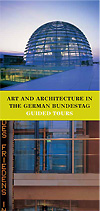Navigationspfad: Homepage > Art and History > Art > Artists
Jörg Herold
Lichtschleife mit Datumsgrenze
Jörg Herold's installation "Lichtschleife mit Datumsgrenze" (Light Loop with the Date Line) is located in the outer courtyard of the Paul Löbe Building, a new parliament building north of the Reichstag. The majority of parliamentary work takes place in this new building, which was designed by the Munich architect Stephan Braunfels. The conference rooms for the German Bundestag's parliamentary committees and offices for the committee chairpersons and their staffs are housed here, as are the visitors' center and its seminar rooms.
The building's architectural language is characterized by basic geometric forms, for example, the square of the ceiling grid or the circle of the rotundas leading to the parliamentary committee conference rooms. Jörg Herold employs one of these basic forms, the circle, and in his installation "Lichtschleife mit Datumsgrenze", has designed the northwest outer courtyard with circular concrete slabs, or "discs," set into the earth. Each of the discs displays a historical date on its surface. These discs extend like a network across the green carpet of evergreen box plants, which are trimmed back to the level of the courtyard ground. A round mirror has been installed at a fixed angle on a landing above the courtyard. The mirror reflects sunbeams onto the discs and their historical dates. Over the course of the year, as the seasons and the position of the sun change, the sunbeams focus on different discs. On January 1, the sunbeams rest on the concrete disc called "Brennpunkt Null" (Focal Point Zero), then shift across the various other discs to the summer solstice disc and later to the winter solstice disc. Each day, the sunbeams highlight a particular date, thereby permitting it to briefly emerge from the darker periods of history. Jörg Herold deliberately selected many of the dates in order to draw attention to historical events that are generally overlooked.
In many of his earlier works, Jörg Herold, who was born in Leipzig, examined the question of history and how it is perceived - from the real events and how they are processed and interpreted on the one hand, to the way myths are created on the other. Herold has always been concerned with upsetting the standard interpretations of seemingly linear courses of history by showing alternate scenes and by focusing on events aside from the widely accepted interpretation of history.
Herold's strategy for the Bundestag installation is based on gathering together historical dates in a "key of dates." This includes dates that are largely unknown to the public: such as Joseph Beuys' crash in a divebomber over Russia in 1944, or the discovery of Kasper Hauser in Nuremberg in 1828, a letter of Mileva Einstein to her husband in 1905 concerning the theory of relativity or the sinking of the refugee ship "Wilhelm Gustloff" in the Baltic Sea by Russian torpedoes in 1945. (The key is available online.)
The recurrent circular shape, which also appears in the artist's Piktografisches Alphabet (Pictogram Alphabet) paintings as the archetype and nucleus of all creation, is closely linked to Herold's view of history. Since time immemorial, a circle has been a planetary sign as well as a symbol of the sun, which is the beginning of any measure of time. The celestial disc recently discovered in Nebra impressively illustrates this. Dating back 3,600 years, the disc may be the oldest known depiction of the cosmos. The sunbeams in Herold's installation move as "traces of light" over the dated discs, thus bringing time in its original cosmic form and the tangible history of mankind together. This circle has no beginning and no end. It does not permit a hierarchy of information, but allows only for an understanding of history akin to a holistic weave, whose individual threads can be emphasized depending on interpretation, and yet remain only a part of the whole.
Jörg Herold's historical cosmos reveals the state of humankind caught between the self-determined fate of the individual and his or her ties to society, and highlights freedom as the chance for personal choice in overlapping historical contexts. Thus, in the Paul Löbe Building, the members of parliament, who are placed in the arena of current political issues, look out at the web of dates created by Jörg Herold - a weave of historical dates from over a millennium, which depicts people as individuals who believe in their sense of personal responsibility and who should simultaneously be aware of their ties to society and the role they play in a supra-individual cosmic order.
Text: Andreas Kaernbach
Curator of the German Bundestag Art Collection


